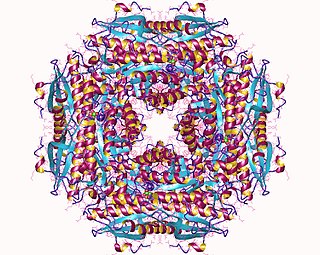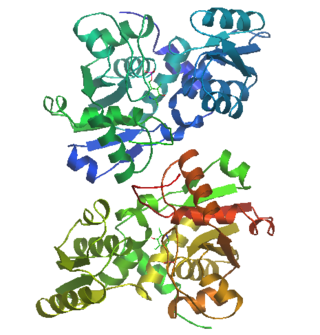
Acetoin, also known as 3-hydroxybutanone or acetyl methyl carbinol, is an organic compound with the formula CH3CH(OH)C(O)CH3. It is a colorless liquid with a pleasant, buttery odor. It is chiral. The form produced by bacteria is (R)-acetoin.

Mandelate racemase is a bacterial enzyme which catalyzes the interconversion of the enantiomers of mandelate via an enol intermediate. This enzyme catalyses the following chemical reaction

The enzyme phenylalanine racemase is the enzyme that acts on amino acids and derivatives. It activates both the L & D stereo isomers of phenylalanine to form L-phenylalanyl adenylate and D-phenylalanyl adenylate, which are bound to the enzyme. These bound compounds are then transferred to the thiol group of the enzyme followed by conversion of its configuration, the D-isomer being the more favorable configuration of the two, with a 7 to 3 ratio between the two isomers. The racemisation reaction of phenylalanine is coupled with the highly favorable hydrolysis of adenosine triphosphate (ATP) to adenosine monophosphate (AMP) and pyrophosphate (PP), thermodynamically allowing it to proceed. This reaction is then drawn forward by further hydrolyzing PP to inorganic phosphate (Pi), via Le Chatelier's principle.
The lactate racemase enzyme (Lar) interconverts the D- and L-enantiomers of lactic acid. It is classified under the isomerase, racemase, epimerase, and enzyme acting on hydroxyl acids and derivatives classes of enzymes. It is found in certain halophilic archaea, such as Haloarcula marismortui, and in a few species of bacteria, such as several Lactobacillus species including Lactobacillus sakei, Lactobacillus curvatus, and Lactobacillus plantarum, as well as in non-lactic acid bacteria such as Clostridium beijerinckii. The gene encoding lactate racemase in L. plantarum was identified as larA and shown to be associated with a widespread maturation system involving larB, larC1, larC2, and larE. The optimal pH for its activity is 5.8-6.2 in L. sakei.

Methylmalonyl CoA epimerase is an enzyme involved in fatty acid catabolism that is encoded in human by the "MCEE" gene located on chromosome 2. It is routinely and incorrectly labeled as "methylmalonyl-CoA racemase". It is not a racemase because the CoA moiety has 5 other stereocenters.
Diacetyl reductase is the name of two acetoin forming enzymes:
Epimerases and racemases are isomerase enzymes that catalyze the inversion of stereochemistry in biological molecules. Racemases catalyze the stereochemical inversion around the asymmetric carbon atom in a substrate having only one center of asymmetry. Epimerases catalyze the stereochemical inversion of the configuration about an asymmetric carbon atom in a substrate having more than one center of asymmetry, thus interconverting epimers.

Serine racemase is the first racemase enzyme in human biology to be identified. This enzyme converts L-serine to its enantiomer form, D-serine. D-serine acts as a neuronal signaling molecule by activating NMDA receptors in the brain.

In enzymology, an alanine racemase is an enzyme that catalyzes the chemical reaction
In enzymology, an allantoin racemase is an enzyme that catalyzes the chemical reaction

α-Methylacyl-CoA racemase is an enzyme that in humans is encoded by the AMACR gene. AMACR catalyzes the following chemical reaction:
In enzymology, an amino-acid racemase is an enzyme that catalyzes the chemical reaction
In enzymology, glutamate racemase is an enzyme that catalyzes the chemical reaction
In enzymology, a methionine racemase is an enzyme that catalyzes the chemical reaction
In enzymology, a tartrate epimerase is an enzyme that catalyzes the chemical reaction
The enzyme acetolactate decarboxylase (EC 4.1.1.5) catalyzes the chemical reaction
Acetoin dehydrogenase (EC 2.3.1.190, acetoin dehydrogenase complex, acetoin dehydrogenase enzyme system, AoDH ES) is an enzyme with systematic name acetyl-CoA:acetoin O-acetyltransferase. This enzyme catalyses the following chemical reaction
Diacetyl reductase ((R)-acetoin forming) (EC 1.1.1.303, (R)-acetoin dehydrogenase) is an enzyme with systematic name (R)-acetoin:NAD+ oxidoreductase. This enzyme catalyses the following chemical reaction

Diacetyl reductase ((S)-acetoin forming) (EC 1.1.1.304, (S)-acetoin dehydrogenase) is an enzyme with systematic name (S)-acetoin:NAD+ oxidoreductase. This enzyme catalyses the following chemical reaction








